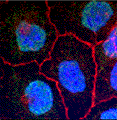Biochemistry, Department of
ORCID IDs
http://orcid.org/0000-0001-5525-7418
http://orcid.org/0000-0002-6495-2655
http://orcid.org/0000-0003-3653-1906
http://orcid.org/0000-0002-9687-7426
Document Type
Article
Date of this Version
2020
Citation
Bioinformatics, 36(16), 2020, 4473–4482 doi: 10.1093/bioinformatics/btaa484 Advance Access Publication Date: 13 May 2020 Original Paper
Abstract
Motivation: Molecular interaction maps have emerged as a meaningful way of representing biological mechanisms in a comprehensive and systematic manner. However, their static nature provides limited insights to the emerging behaviour of the described biological system under different conditions. Computational modelling provides the means to study dynamic properties through in silico simulations and perturbations. We aim to bridge the gap be- tween static and dynamic representations of biological systems with CaSQ, a software tool that infers Boolean rules based on the topology and semantics of molecular interaction maps built with CellDesigner.
Results: We developed CaSQ by defining conversion rules and logical formulas for inferred Boolean models accord- ing to the topology and the annotations of the starting molecular interaction maps. We used CaSQ to produce exe- cutable files of existing molecular maps that differ in size, complexity and the use of Systems Biology Graphical Notation (SBGN) standards. We also compared, where possible, the manually built logical models corresponding to a molecular map to the ones inferred by CaSQ. The tool is able to process large and complex maps built with CellDesigner (either following SBGN standards or not) and produce Boolean models in a standard output format, Systems Biology Marked Up Language-qualitative (SBML-qual), that can be further analyzed using popular model- ling tools. References, annotations and layout of the CellDesigner molecular map are retained in the obtained model, facilitating interoperability and model reusability.
Included in
Biochemistry Commons, Biotechnology Commons, Other Biochemistry, Biophysics, and Structural Biology Commons



Comments
The Author(s) 2020. Published by Oxford University Press.